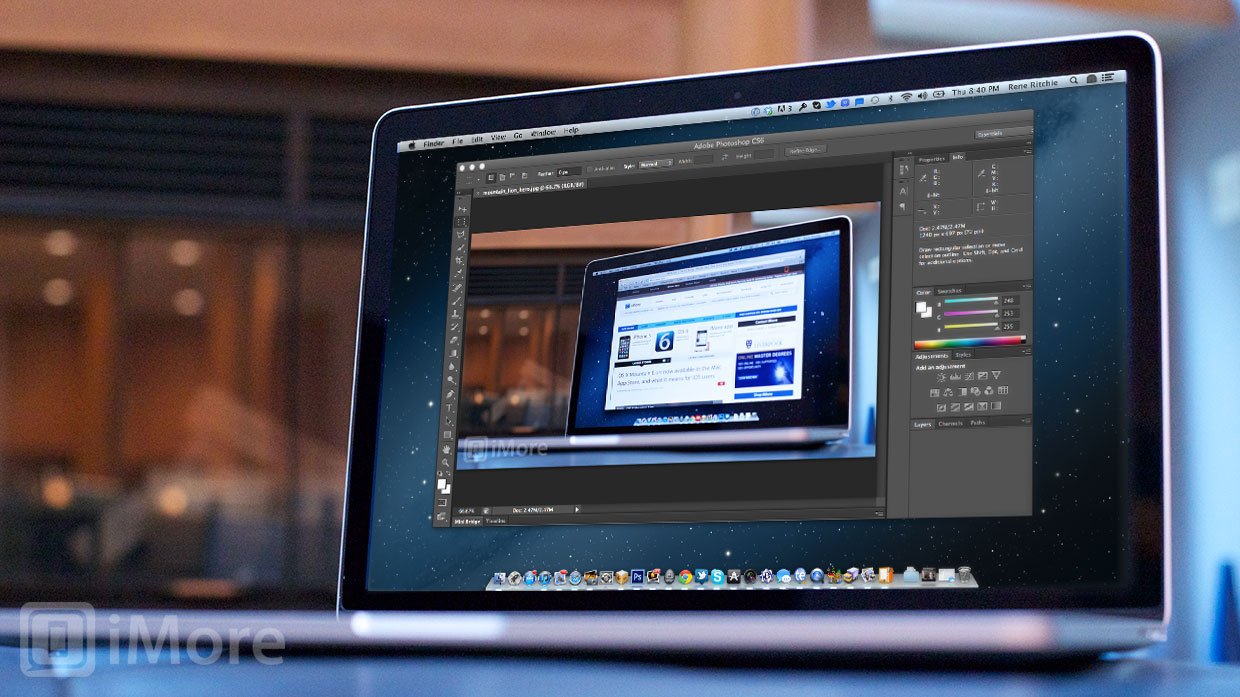- Create all the things Best PCs for Adobe Creative Cloud in 2020 If you're a creator relying on Adobe's suite of products, these are the PCs to get.
- Adobe is changing the world through digital experiences. We help our customers create, deliver and optimize content and applications. All together now. The new release of Adobe Creative Cloud gives you all the best creative apps and services, so you can stay more connected and creative wherever you're inspired. Start free trial.
- Adobe Creative Suite CS6 Master Collection for Mac - Disks & Retail license. Apple Macbook Air 13inch 2019 + ADOBE PHOTOSHOP, AUDITION 2020, FINAL DRAFT 11.
- Adobe Creative Suite Pricing
- Adobe Creative Suite Download
- Macbook Air Adobe Creative Suite Download
- Macbook Air Adobe Creative Suite 6 Master Collection
Creative Cloud is a collection of 20+ desktop and mobile apps and services for photography, design, video, web, UX, and more. Now you can take your ideas to new places with Photoshop on the iPad, draw and paint with Adobe Fresco, and design for 3D and AR. Join our global creative community — and make something better together. Apple is renowned for making excellent products for creative professionals, and the 13-inch MacBook Pro with Touch Bar is the best laptop for graphic design. It's also the best MacBook Pro that.
Creative Suite applications are not supported on macOS 10.12 (Sierra), macOS 10.13 (High Sierra), and macOS 10.14 (Mojave). Therefore, many of the Creative Suite installers may not function normally on them. See the information below for available workarounds to install Creative Suite applications under macOS 10.12- 10.14.
Note:
You cannot install Creative Suite apps on macOS 10.15 (Catalina).
For a list of system requirements, and tested operating systems, see System requirements | Master Collection.
Mount the Disk Image file for the Creative Suite 6 application.
Right-click Install.app and select Open Package Contents from the context menu.
A terminal window opens and initializes the installer. You are given the option to install in trial mode, utilize a serial number, or verify a Creative Cloud membership.

Mount the Disk Image file for the Creative Suite application.
Right-click Install.app and select Open Package Contents from the context menu.
Note:
Navigate to Go > Utilities to open the Terminal window.
Seven years ago this summer, I switched from Windows to Linux as my primary desktop operating system. And while there have been ups and downs, I have no real regrets about that decision. Linux, or more specifically Ubuntu, remains, in fact, the operating system on my primary machine, a Dell workstation.
But as of August 24th, I became a (part time) Mac user for the first time since college. Because I've been using Linux for so long, a few people have asked why I made the decision to get a Mac. This is my answer.
Hardware
It's been said that Apple's single biggest competitive advantage isn't its devices, but rather its supply chain. The iPad revenue stream alone would support this argument, but the reality is that Apple can make better hardware, cheaper than anyone else. Like Jeff, the single most compelling reason to get a Mac was the hardware.
It's not perfect – the battery life in particular on the 11″ Air (i7) is disappointing – but the overall package is light, performant and aesthetically attractive. It's close to perfect for frequent travelers; the battery's the only major flaw.
Unix
While I actually like Windows 7 – I have a few virtual instances of it running on my workstation – it's not an option for me simply because I don't want to deal with Cygwin. I'm not a developer, but I use a lot of tools that require a Unix core, so for me that means Linux or Mac. There are little differences between the userlands, but overall most of the scripts, libraries and applications I use on Linux run comfortably on the Mac out of the box.
OS X
I'm not as comfortable on OS X as I am on Linux, but that's to be expected: I've been using the latter for seven years, the former for three months. I cannot, therefore, objectively evaluate the usability of OS X. Nor can I comment on the ‘bloat' that frustrates Tim O'Reilly, as I have no basis for comparison.
I can say, however, that the Mac has been substantially less stable than anticipated. My MBA is crashing about once a week, where crashing means I'm required to power cycle the machine. Whether this is Apple's fault or the fact that I push my hardware very hard isn't clear, but either way the experience has not been as advertised.
In general, OS X is nothing more or less than opinionated software. It is heavily prescriptive, and while its approach is inconsistently successful, it is difficult to look at the application breadth and polish and build the case against. And love or hate their individual design decisions, like the omnipresent top menu (I'm not a fan), Apple is by most measures the best in the world at user experience.
Apps
One of the interesting discoveries of my brief Mac tenure has been that the App Store is, by and large, a failure. Of the 93 items in my Applications folder, the App Store claims to have installed 11. By rough count, then, 12% of my applications are installed and managed through the App Store. Anecdotally, this experience seems common; most of the people I speak with are not relying on the store as their primary installation mechanism. On Ubuntu, by contrast, all but a handful of my applications were centrally installed, managed and updated. The App Store application itself, meanwhile, has been buggy, particularly when installing or updating very large applications such as Xcode.
While the store experience has been poor, however, the individual applications themselves are impressive. Conventional wisdom argues that Mac apps are, as a rule, more polished aethetically than their Linux or Windows counterparts. In this case, the conventional wisdom has born scrutiny. Apple makes it comparatively easy for their developers to construct attractive applications.
Apple's own apps, meanwhile, have exceeded my expectations. While the import/export options are disappointing, I already prefer Keynote to Powerpoint, which in turn I prefer to OO.o's Impress. Numbers, meanwhile, is not a functional match for Excel, but from a charting perspective I find its graphs and visualizations far more appealing than the Excel defaults.
And then there are the applications that are available on OS X but not Linux, such as the Adobe Creative Suite.
Adobe Creative Suite Pricing
The Net
Adobe Creative Suite Download
I like the MacBook Air. The hardware is elite, and while the operating system occasionally frustrates, it's generally well thought out and aesthetically without peer. I have no plans to abandon Ubuntu on my workstation, but I am somewhat concerned about the state of the user interface on that platform at present as the fragmentation of effort has negatively impacted its direction, in my opinion.
Macbook Air Adobe Creative Suite Download
That said, OS X has its own challenges; when high profile users like Tim are frustrated, you have a problem. Bigger picture, there are concerns about Apple's appetite for control of application delivery. If sandboxing is required, for example, for applications delivered through the App Store, the logical next is either requiring it for all applications or restricting installation to the store. Either of which would be problematic for developers and users alike.
Macbook Air Adobe Creative Suite 6 Master Collection
In the meantime, however, I'm happy to have added OS X to my technical arsenal.

